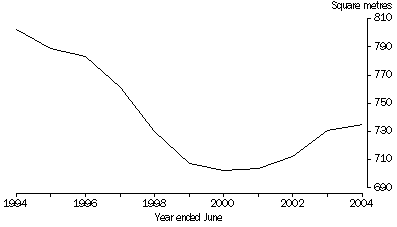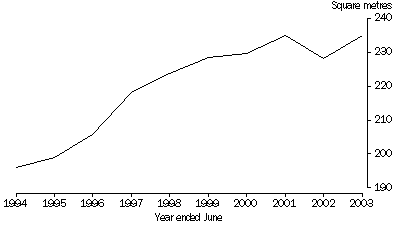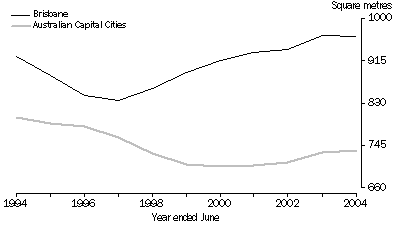Feature Article - Are we buildng on smaller blocks?
INTRODUCTION
An article released in the November 2003 issue of Building Approvals, Australia (cat. no. 8731.0) highlighted the increasing size of new houses being built in Australia. This article presents data on site area, which is the size of land that new houses are being built on. It shows a growing trend of building bigger houses on smaller blocks.
SITE AREA OF NEW HOUSES
Graph 1 shows how the average site area of new houses in Australian capital cities has decreased over the last 11 years. In 1993-94, the average site area was 802m2, compared to 735m2 in 2003-04. The graph shows there has been a steady decrease in the site area of new houses from 1993-94 to 1999-00. Over the last four years, however, site area has been increasing.
Graph 1. Average Site Area of New Houses in Australian Capital Cities, Trend

FLOOR AREA OF NEW HOUSES
While the site area of new houses has decreased over the last eleven years, the floor area of new houses being built has increased. In 1993-94, the average floor area of new houses built in Australian capital cities was 196m2 . In 2002-03, the average size was 235m2. Graph 2 shows there has been a steady increase in the size of new houses over the last 10 years, although the average did fall in 2001-02. Data for the first three quarters of 2003-04 indicates the average size of new houses is still increasing (239m2).
Graph 2. Average Floor Area of New Houses in Australian Capital Cities

GROWTH AREAS
Table 1 shows the average site area of new houses in selected growth areas around Australia. These growth areas were selected based on the number of new house approvals and the level of site area reporting.
TABLE 1. AVERAGE SITE AREA OF NEW HOUSES, Selected Growth SLA's |
|  |
 |  | 1993-94 | 1994-95 | 1995-96 | 1996-97 | 1997-98 | 1998-99 | 1999-00 | 2000-01 | 2001-02 | 2002-03 | 2003-04 |  |
| SLA(a) | m2 | m2 | m2 | m2 | m2 | m2 | m2 | m2 | m2 | m2 | m2 |  |
|  |
| New South Wales |  |  |  |  |  |  |  |  |  |  |  |  |
 | Bankstown (C) | n.a. | n.a. | n.a. | n.a. | n.a. | 667 | 665 | 666 | 590 | 608 | 614 |  |
 | Liverpool (C) | n.a. | n.a. | n.a. | n.a. | n.a. | 573 | 565 | 540 | 514 | 564 | 549 |  |
 | Gosford (C) | n.a. | n.a. | n.a. | n.a. | 763 | 719 | 720 | 728 | 717 | 743 | 718 |  |
| Victoria |  |  |  |  |  |  |  |  |  |  |  |  |
 | Melton (S) - East | n.a. | 716 | 748 | 718 | 776 | 656 | 627 | 570 | 608 | 618 | 571 |  |
 | Hume (C) - Craigieburn | n.a. | n.a. | n.a. | 843 | 712 | 692 | 654 | 621 | 610 | 602 | 549 |  |
 | Whittlesea (C) - South | n.a. | 623 | 618 | 588 | 592 | 582 | 538 | 525 | 540 | 346 | 565 |  |
 | Manningham (C) - West | n.a. | n.a. | 1,155 | 977 | 919 | 663 | 828 | 778 | 739 | 773 | 705 |  |
 | Casey (C) - Berwick | n.a. | n.a. | 722 | 717 | 739 | 749 | 741 | 697 | 684 | 664 | 721 |  |
 | Casey (C) - Cranbourne | n.a. | n.a. | n.a. | 643 | 588 | 532 | 607 | 578 | 613 | 588 | 648 |  |
| South Australia |  |  |  |  |  |  |  |  |  |  |  |  |
 | Tea Tree Gully (C) - North | 596 | 634 | 626 | 658 | 656 | 646 | 604 | 542 | 545 | 630 | 735 |  |
| Western Australia |  |  |  |  |  |  |  |  |  |  |  |  |
 | Swan (C) | n.a. | 710 | 720 | 722 | 709 | 662 | 627 | 727 | 718 | 728 | 814 |  |
 | Wanneroo (C) - North-West | 666 | 654 | 639 | 654 | 677 | 660 | 613 | 645 | 613 | 599 | 588 |  |
 | Cockburn (C) | 725 | 695 | 640 | 719 | 639 | 612 | 606 | 597 | 622 | 593 | 604 |  |
 | Melville (C) | 880 | 826 | 791 | 780 | 659 | 591 | 642 | 594 | 602 | 557 | 575 |  |
 | Rockingham (C) | 694 | 681 | 698 | 845 | 696 | 705 | 712 | 746 | 697 | 685 | 682 |  |
| Northern Territory |  |  |  |  |  |  |  |  |  |  |  |  |
 | Palmerston (C) Bal | n.a. | 732 | 990 | 736 | 707 | 687 | 697 | 665 | 599 | 698 | 764 |  |
|  |
| (a) Some SLA's have changed name and area over the period of analysis. The SLA names shown are current for 2003/04. |
For most growth SLA's in Australia, there has been a noticeable decrease in the site area of new houses. In Bankstown, NSW, for example, the average block size of new houses has decreased from 667m2 in 1998-99 to 614m2 in 2003-04.
Most selected growth areas in Victoria have seen a significant decrease in the site area of new houses. In Melton - East, the average site area has decreased from 716m2 in 1994-95 to 571m2 in 2003-04. Similarly, the average site area of new houses in Hume - Craigieburn decreased from 843m2 in 1996-97 to 549m2 in 2003-04.
Some growth areas in Australia have maintained, and even increased, the site area of new houses over the last decade. In South Australia, Tea Tree Gully - North has seen an increase in site area from 596m2 in 1993-94 to 735m2 in 2003-04. In Western Australia, Swan has seen an increase in site area from 710m2 in 1994-95 to 814m2 in 2003-04. Other SLA's in Western Australia such as Wanneroo - North West, Cockburn and Melville have seen a decrease in the site area of new houses. In Melville, for example, site area has decreased from 880m2 in 1993-94 to 575m2 in 2003-04.
The largest growth area in the Northern Territory over the last decade has been Palmerston. The average site area of new houses in Palmerston Bal has fluctuated between a high of 990m2 in 1995-96 to a low of 599m2 in 2001-02.
The experience in Brisbane has been notably different to the national average for all Australian capital cities. Graph 3 shows the site area of new houses in Brisbane Statistical Division has increased over the last decade from 923m2 in 1993-94 to 964m2 in 2003-04. This is well above the national average of Australian capital cities (735m2).
Graph 3. Average Site Area of New Houses, Trend

Some caution should be used with this data as site area was only reported for about 50% of new house approvals in Australian capital cities, while floor area was reported for about 90% of newly completed houses. Site area and floor area data can be affected by changes in the composition of dwelling units reporting those data items.
If you have any queries about site area data, please contact Melanie Wilson on Adelaide (08) 8237 7382.
 Print Page
Print Page
 Print All
Print All